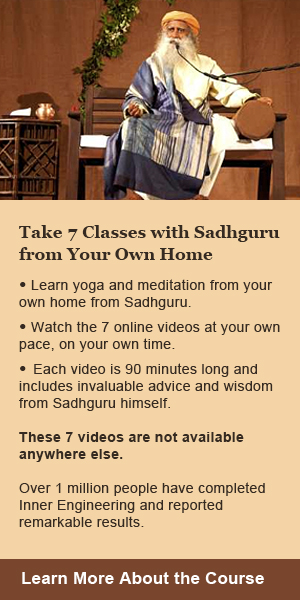Why Shambhavi?

“There is a certain way to engineer our system, to make this body, to make this mind… the very chemistry within us the way we want it.” —Sadhguru
When people talk of yoga and meditation, the phrase that often comes as a rider is “peace of mind.” Teachers and practitioners of meditative techniques have always enumerated the wonderful mental and physical benefits of these practices. While people who practice meditation experience this first-hand, to the rational mind, which seeks empirical proof for everything, this may seem like fuzzy wishful thinking.
Isha’s introductory practice is the Shambhavi Maha Mudra, an ancient kriya that has millions of dedicated practitioners who aver that they experience greater emotional balance, better health, concentration, focus and stability with regular practice. In fact, there have been several scientific studies that measure various outcomes of regular practice of the kriya[1] – both with regard to brain activity during the kriya, as well as statistical research of how it affects people’s health and well-being.
How does the Kriya Work?
Sadhguru says, “There is a certain way to engineer our system, to make this body, to make this mind… the very chemistry within us the way we want it.” Traditionally, yoga sees the human being as five layers of body: the physical body, the mental body, the pranic energy body, the etheric body and the bliss body. The reason why most people are unhappy or unhealthy is that the physical, the mental and the “pranic” body are not in alignment. Sadhguru explains, “If they are properly aligned, a natural expression, an overwhelming expression of joyfulness will naturally happen within a human being. Now, we are looking at the technology of keeping these three bodies constantly aligned so that joyfulness is not an accidental happening; joyfulness becomes a normal condition, a natural way of living for you.”
The Studies
Studies on Shambhavi Maha Mudra have been varied: some have examined its impact on disease status and medicine usage, some have looked specifically at menstrual disorders, while others have studied its impact on sleep, heart rate variability, brain activity, etc. Other studies have researched general well-being and improved attention spans among regular meditators.
The Results
The results have been amazing. For instance, it is now clear that regular practice either leads to a stop in the use of medication or at least reduces it considerably for a range of ailments from allergies to hypertension, from depression to thyroid. When it came to menstrual issues, a substantial majority of women surveyed reported reduction in work impairment, reduced irritability and mood swings, reduction in pain, as well as the need for medicines or surgery.
Heart Rate Variability studies show that this practice causes greater balance of the Cardiac Autonomic Nervous System, thereby enhancing the ability of the heart to respond better and more effectively to various stressful situations. This is supported by a polysomnographic study that showed a statistically significant improvement in the efficiency of sleep among practitioners.
Neurocognitive tests demonstrated increased performances in attention-oriented tasks, while EEG studies on meditators showed higher levels of coherence between the right and left hemispheres of the brain, leading to greatly enhanced mental capabilities: better learning ability, increased creativity, heightened mental clarity and sharper intellect.
Another test, a neurophysiological study using EEG revealed a substantial increase in delta and theta brain waves and markedly reduced beta and alpha brain waves when measured after 21 minutes of the practice of Shambhavi Maha Mudra. Increase in delta and theta waves are associated with deep relaxation and higher levels of mental focus, while reduced beta waves are associated with reduced mental tension and anxiety. Reduced alpha waves in conjunction with increased theta and delta waves are associated with conscious awareness of the subconscious mind. Taken together, these results support a drop in stress and anxiety, a boost in mental alertness and focus, and an increase in self-awareness.
And the beauty of it all is that the practice takes a mere 21 minutes of your day. What are you waiting for?!


